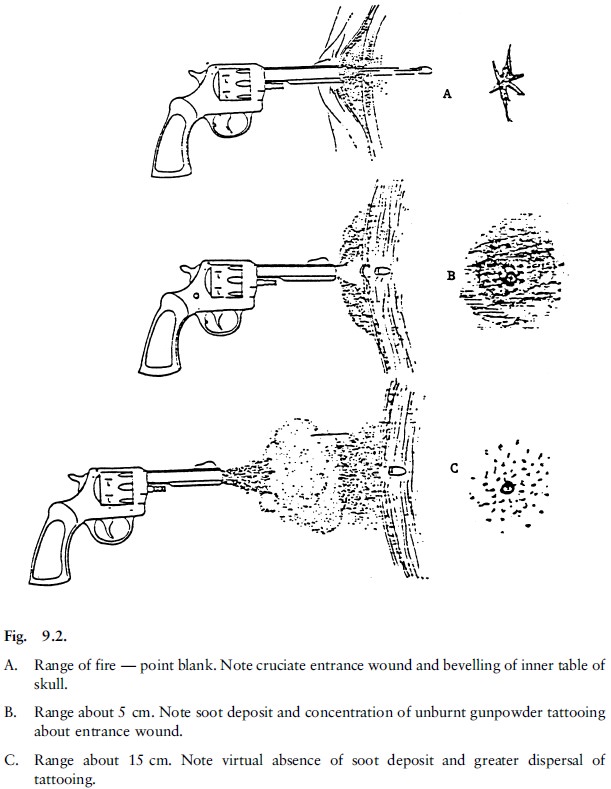Chapter: Forensic Medicine: Firearm injuries
Pathophysiology of gunshot wounds and wound ballistics
Pathophysiology of gunshot wounds and wound
ballistics
Injuries caused by missiles entering live tissue
are directly related to the amount of kinetic energy transferred from the
missile to the target tissue. This energy is expressed by the equation Ek
= ‰ mv2, where the exponential factor of velocity represents the
greatest contribution to energy transferred. The mass is also of importance.
Therefore, the damage caused by a bullet is determined not only by the
velocity, but also by tissue resistance (the greatest amount of energy is
transferred at the point where tissue resistance is maximal), the yaw (angle of
the bullet in relation to its trajectory path), the bullet's tumble effect
after it hits the target tissue, the bullet weight, and the extent of bullet
fragmentation.
In shotgun injuries, especially those inflicted at close range, the total mass of the individual projectiles is a very important factor in the kinetic energy equation. At close range the pellets act as a solitary missile because of tight clustering, and their total weight is much greater than that of individual rifle or handgun bullets. Furthermore, the ballistically poor design of multiple small, round balls does not favour maintenance of high kinetic energy at considerable distances from the muzzle, nor does it permit great tissue penetration. However, at close ranges (ie up to about 3 m in the case of shotguns) the energy release generally causes massive tissue disruption close to the point of penetration. For this reason close-range shotgun injuries have many of the characteristics of high-velocity missile war wounds.

When a missile enters tissue a temporary pulsing
cavity, in which the tissues undulate and stretch and compress, is formed along
the missile tract within 10 to 30 milliseconds after impact. This cavity can be
as large as 30 to 40 times the diameter of the bullet. This phenomenon, that
has been seen in muscle, liver, bone, brain, lungs, and arteries, is caused by
energy released by the missile, forming shock waves with pressures of up to 100
to 200 atmospheres directly related to missile velocity, and imparting momentum
to the tissues, both forward and laterally. In addition there is mechanical
damage due to the shearing effect between tissues of differing heterogeneity
and density. The actual cavity created by the missile rapidly collapses behind
the projectile as a result of tissue elasticity, haemorrhage and oedema,
leaving a smaller permanent pathway usually marked by tissue loss, haemorrhage,
bullet fragments or sometimes bone fragments which can be seen during
radiological examination shortly after injury. Bullet fragmentation is a major
cause of tissue disruption and there is a close connection between large exit
wounds and bullet fragmentation.
The critical velocity at which bone is fractured
is approximately 66 m/s. Kinetic energy imparted to the tissue causes bone to
fracture. Although some bone fragments may be contained within the surrounding
framework of the periosteum (bone membrane), muscle and connective tissue,
others may have sufficient energy to act as secondary missiles, creating
further destruction and multiple exit-wounds. The medical examiner may thus be
faced with a discrepancy between the number of entrance and exit wounds.
In low-velocity gunshot wounds, defined as those
inflicted by missiles travelling at a velocity of less than 360 m/s (ie most
handguns), the energy transferred to the tissues is considerably less than that
of high-velocity missiles, resulting in less tissue destruction. As an
interesting rider: the Soviet AK-47 assault rifle, despite the high velocity
(900 m/s at the muzzle) and marked tendency of its bullet to yaw after
penetration, causes relatively non-dramatic wounds in the more elastic soft
tissues (muscle, bowel wall, lung) because of its nonfragmenting behaviour, but
multiple fractures and massive disruption in inelastic tissues such as bone and
liver.
Related Topics